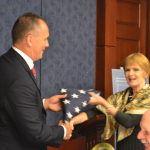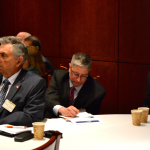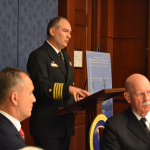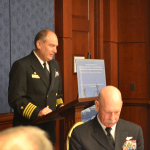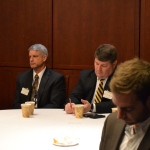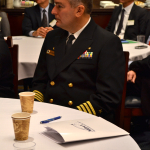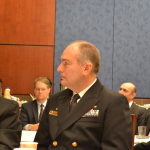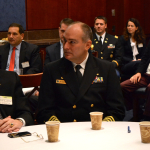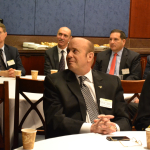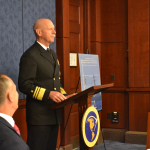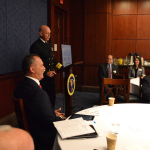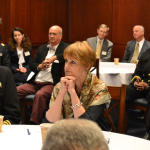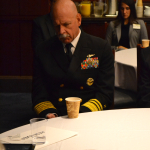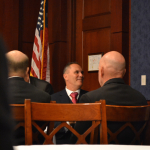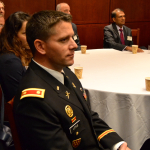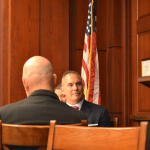In the United States Capitol, we honored and recognized a decade of the U.S. Navy’s operation of Aegis Ballistic Missile Defense ships. Joining us for this historic occasion was the “Mother” of the Aegis BMD system, RADM (ret) Kate Paige, the Chief of Staff for the United States Navy, Vice Admiral Scott Swift, and the current technical director of Aegis Ballistic Missile Defense for the Missile Defense Agency, Captain Michael Anderson. RADM Kate Paige was the first program director of Aegis Ballistic Missile Defense for MDA and was the technical pioneer of the system, and followed in the footsteps of the the “Father” of the Aegis Ballistic Missile Defense system, the late Rear Admiral Wayne Meyer. Rear Admiral Meyer led the way in the “build a little, test a little, learn a lot” increments that have resulted in the most successful, most reliable, and most proven missile defense system in the world today.
Today, Aegis BMD is deployed on 37 ships around the world in the Pacific Ocean, the East China Sea, the Sea of Japan, the Persian Gulf, the Mediterranean Sea and the Atlantic Ocean keeping our world safe. Four of those 37 ships belong to the Maritime Self Defense Force of Japan with Australia considering placing Aegis BMD capability on their upcoming new navy ships. There will be an additional ten more U.S. Aegis ships becoming BMD capable in eventuality of a pure fleet of all US Navy Aegis Destroyers and Cruisers being BMD capable in the future.
Over the past ten years, Aegis Ballistic Missile Defense ships have been engaged during all of North Korea’s long range ballistic missile tests, using their A/N SPY 1 radars to provide the critical link of tracking into the U.S. homeland missile defense system. These BMD Ships have also been on patrol and on station in the Persian Gulf against Iranian short and medium range threats. They have been on patrol off the coast of Israel and Syria, providing ballistic missile defense and tracking of the Scuds being fired regularly inside of Syria. They have patrolled in the Black Sea to signal NATO resolve to Russia during the Ukraine crisis. They were put on full deployment rotations in 2013 for Phase 1 of the European Phased Adaptive Approach in the protection of Europe from Iran. They have the distinct honor of successfully shooting down a toxic satellite falling down to Earth. Aegis BMD has continued to test and build to be better each of those ten years. The most recent test earlier this month, the most advanced yet, validated the Baseline 9 by simultaneously shooting down a raid of one ballistic and and two cruise missiles.
“The operational performance of Aegis BMD covers the broadest range of missile threats, including terminal threats in the endo-atmosphere, short medium and intermediate ranged threats in the exo-atmosphere, and soon Aegis BMD with SM-3 will be providing defense from land based sites as well on the sea.” Said RADM (ret) Kate Paige in her remarks at the tenth anniversary event. “None of this would have been possible if not for the partnership between industry and government that was formed by Rear Admiral Wayne Eugene Meyer, or without the balance between weapon system and missile that they collectively engineered.”
With all of these great technical achievements and advancements of Aegis BMD – to include shoot on remote, engage on remote, Aegis Ashore, SM3 Block IB, Baseline 9 and the upcoming SM-3 Block IIA with the Japanese – its not only the pace setter, its the future for ballistic missile defense as it represents an operational and fully-integrated air and missile defense system on a single mobile platform. This operational example of tremendous success in integrated air and missile defense propels way beyond Aegis BMD ships, to our joint military services and to our allies to collectively be integrated for the prevention, deterrence, and defense against the common threat.
As Vice Admiral Swift noted, Aegis BMD “has not just given us a tool, but a toolkit.”
The first operations of Aegis Ballistic Missile Defense happened a decade ago out of the 7th Fleet, Yokosuka, Japan in the East China Sea in the defense of the United States and Japan against North Korea. The first operational Aegis BMD ship was DDG 54, the USS Curtis Wilbur. Flags flown from that ship were presented at the United States Capitol to RADM(ret) Kate Paige and to the Chief of Naval Operations Jon Greenert, who commanded the 7th Fleet ten years ago when Aegis Ballistic Missile Defense first became operational.
Aegis BMD is second to none in the world, a true fully integrated air and missile defense system. It is to this great mobile platform that we commemorate with those and to all those that built, tested, developed and deployed this great technology that we recognize and celebrate.













